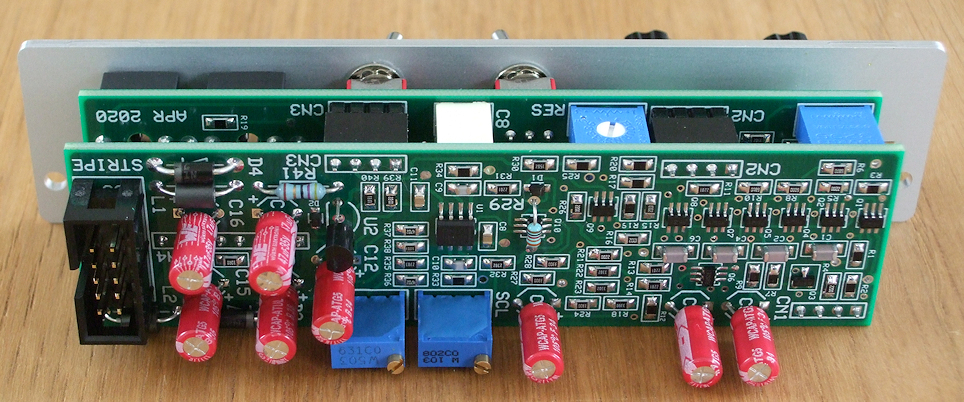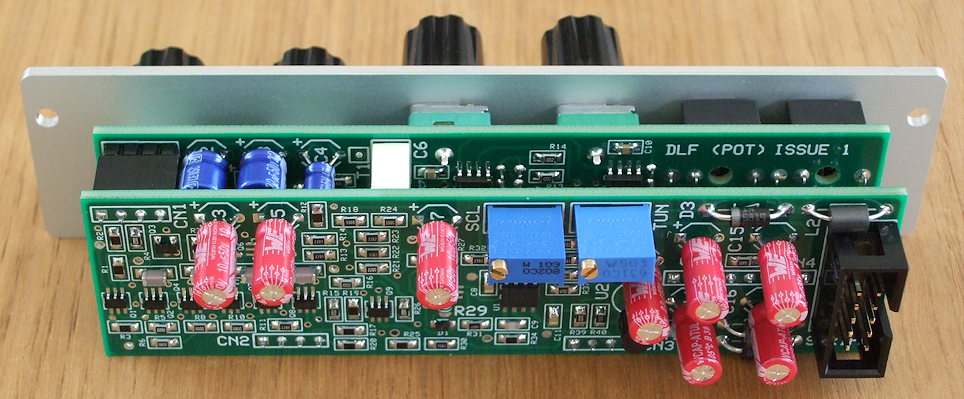
Constructional difficulty: Moderate with surface mount parts.

The Oakley Discrete Ladder Filter (DLF) is my reworking of the classic 1960's low pass filter module. Inspired by the circuits of the 904A filter and CP3 mixer, the DLF combines them into one excellent sounding 6HP wide module.
The audio signal pathway is almost all discrete components with a dual IC op-amp only providing the input and output signal processing for the drive control.
Before entering the 904A style filter core, the audio signal passes through a clone of the CP3 mixer. The original CP3 module had two outputs, an inverted output and a non inverted output. Apart from the change in phase, the two outputs sounded different to one another when the input signal was particularly loud and the output of the CP3 started to clip. The distortion heard when clipping takes place is both unique and musically interesting. The Oakley DLF has a front panel switch to select which of the input stage's two outputs go on to the filter circuit, Mode A or Mode B. The DLF's input stage has been designed to start to clip when the input signal is around +/-4V, but keeping the signal below this will ensure a clean signal.
Turning up the DLF's Drive control allows the filter core to be overdriven, without changing the output volume, and dramatically changes the sound at higher resonance settings. The Drive control only affects the filter core and has no affect on the input stage. So with variations in input level and drive level it is possible to utilise the overdrive characteristics of only the input stage, only the filter, or both for a really heavy sound.
The filter will self oscillate at high resonance. However, like the original module, the filter won't self oscillate much below 75Hz. When sweeping the filter's cut-off frequency at high resonance, this limited resonance at low frequencies gives the filter a powerful bass sound.
Although the module can be used as a filter module on its own, it is expected that you use an external mixer, such as the Oakley Multimix, to combine and control the audio levels going into the module.
Two control voltage (CV) inputs are available on the front panel. CV1 offers the standard 1V/octave control over the cut-off frequency. While CV2 has a depth control which can be varied from off to up to 0.5V/octave, and has additional switch that can invert CV2 if negatively going sweeps are desired.
The module requires +/-12V and has a current consumption of +60mA and -50mA.
The PCB Set

The DLF module comprises of two printed circuit boards (PCBs) connected together with four 0.1” (2.54mm) single in line (SIL) headers and sockets. The main board on the rear of the module houses the power input and conditioning, the filter core, and CV processing circuitry. The pot board has the pots, switches, and sockets that are attached to the front panel, as well as the discrete input stage, overdrive circuitry and CV2 processing circuit. To achieve good circuit performance in a small space both boards are four layer designs. Each board is the same size; 29 mm x 107 mm.
The majority of the components are surface mount parts. The dual op-amps are SOIC, while the resistors and surface mount capacitors are 0805. The dual matched transistors are in small SOT457 packages. There is no requirement to hand match transistors. All components are standard parts.
Sound Samples
All the following samples use an Oakley D-VCO which connects to an Oakley Multimix and then to the DLF. The output of the DLF is fed into an Oakley Classic VCA and both the DLF and VCA are each controlled by an Oakley Envelope.
Here are three bass notes using the DLF at high resonance. The drive is at minimum for the first note, half way around for the second note, and on full for the second note.
This one plays back a simple sequence while the controls of the DLF are manually tweaked.
A single note drone with the DLF almost in self oscillation. The frequency and drive controls are manually swept. Notice how driving the filter core harder in the second half reduces the self-oscillation. Some reverb has been added for ambience.
A dry sample of a simple sequence being played while the emphasis control is changed.
Another sample of a simple two note octave sequence being played while the emphasis control is increased and decreased.
A more complex sequence with the frequency and envelope depth controls being manually tweaked. A little delay has been added for a bouncy effect.
Here we hear a single triangle wave with the filter's frequency control turned up full and the emphasis control at its minimum. We are therefore listening to the effects of the input stage in Mode B as we firstly increase the signal level so the input stage starts to clip, and then, using the Multimix's ability to add an offset voltage, how that clipping can be turned on harder to change the sound even more.
Prices
Click here for ordering details.
DLF (Euro) main board issue 1 PCB...........................................
10GBP
DLF (Euro) pot board issue 1 PCB
............................................. 10GBP
Both boards are required to build the Oakley DLF for Eurorack project.
All other parts can be purchased from your usual electronic component supplier.
All prices include VAT at UK rates. Shipping is additional to these prices. See also the FAQ page.
Project Downloads
Builder's Guide Parts Lists, calibration and building information
Construction Guide My handy guide to building Oakley DIY projects
Parts Guide My handy guide to buying parts for Oakley DIY projects
Schematics are only available to purchasers of the PCBs and will only be sent via e-mail when the boards are shipped.
Front Panel database
A Schaeffer front panel can be made for this module. The database can be found by downloading the following link:
6HP Eurorack format in natural silver
To read, edit and print these files you will need a copy of 'Frontplatten Designer' from Schaeffer. Panels can be ordered via the program using its web based ordering system.
Schaeffer are based in Berlin, Germany and can send panels to anywhere in the world. Delivery to the UK normally takes around ten days. For North American users you can also order your Schaeffer panels from Front Panel Express.

Back to projects page: Projects
Back home